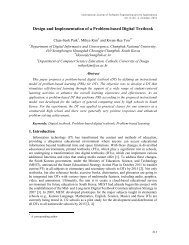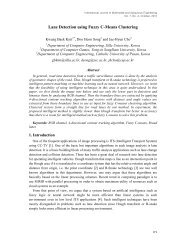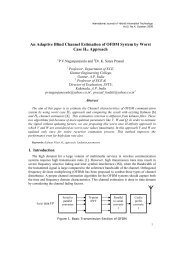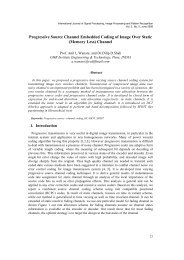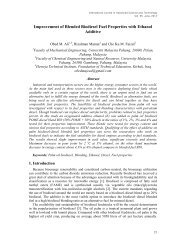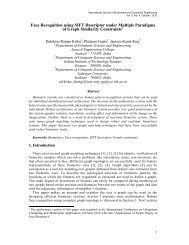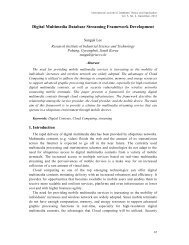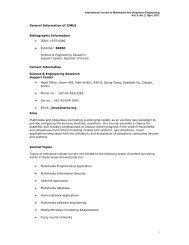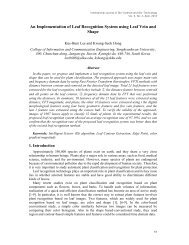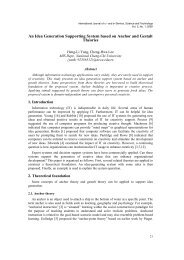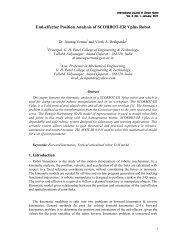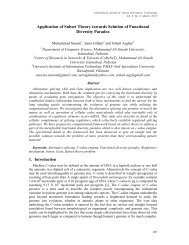A Communication Protocol of RFID Systems in Internet of Things
A Communication Protocol of RFID Systems in Internet of Things
A Communication Protocol of RFID Systems in Internet of Things
Create successful ePaper yourself
Turn your PDF publications into a flip-book with our unique Google optimized e-Paper software.
International Journal <strong>of</strong> Security and Its Applications<br />
Vol. 6, No. 2, April, 2012<br />
× <strong>in</strong>dicate whether the protocol has the ability to resist the attacks or not, respecti vely.<br />
From table 2, We can see clearly that SPAP can resist all k<strong>in</strong>ds <strong>of</strong> security attacks, and<br />
will be able to realize the key update and the ownership transfer <strong>of</strong> tags.<br />
Table 2. Comparison <strong>of</strong> Safety Performance<br />
<strong>RFID</strong> <strong>Protocol</strong> Hash-Lock Random Library <strong>RFID</strong> Ownership EC-RAC SPAP<br />
Hash-Lock<br />
Transfer<br />
Mutual authentication √ √ √ √ √ √<br />
Forward security √ √ √ √ √ √<br />
Internal security × × × × × √<br />
Resist track<strong>in</strong>g attack × × √ × × √<br />
Resist replay<strong>in</strong>g attack × × √ √ √ √<br />
Indist<strong>in</strong>guishable √ √ √ √ √ √<br />
Key update × × × √ √ √<br />
Ownership transfer × × × √ × √<br />
6. Conclusion and Future Work<br />
<strong>RFID</strong> systems are critical for <strong>in</strong>ternet <strong>of</strong> th<strong>in</strong>gs, therefore, the safe problems <strong>of</strong> <strong>RFID</strong><br />
systems becomes one <strong>of</strong> the ma<strong>in</strong> tasks for develop<strong>in</strong>g the <strong>in</strong>ternet <strong>of</strong> th<strong>in</strong>gs. This paper<br />
analyzes advantages and disadvantages <strong>of</strong> several typical <strong>RFID</strong> protocols, summarizes<br />
the special security needs <strong>of</strong> <strong>RFID</strong> systems <strong>in</strong> <strong>in</strong>ternet <strong>of</strong> th<strong>in</strong>gs, proposes a secureprovably<br />
authentication SPAP.<br />
Proved by the random oracle model, SPAP can achieve mutual authentications,<br />
<strong>in</strong>ternal security, ownership transfer <strong>of</strong> tags, what’s more, SPAP can also resist<br />
retransmission, track<strong>in</strong>g <strong>of</strong> some basic attacks. F<strong>in</strong>ally, accord<strong>in</strong>g to the result <strong>of</strong><br />
analyz<strong>in</strong>g the safe performance, SPAP protocol has good performance.<br />
The <strong>in</strong>novation <strong>of</strong> SPAP lies <strong>in</strong> solv<strong>in</strong>g the <strong>in</strong>ternal attacks and security issues <strong>of</strong><br />
ownership transfer for sett<strong>in</strong>g dynamic authentication keys between any legitimate tags<br />
and legitimate readers. In addition, us<strong>in</strong>g the random oracle models is also very novel.<br />
References<br />
[1] V. Kolias, I. Giannoukos, C. Anagnostopoulos, I. Anagnostopoulos, V. Loumos and E. Kayafas, “Integrat<strong>in</strong>g<br />
<strong>RFID</strong> on event-based hemispheric imag<strong>in</strong>g for <strong>in</strong>ternet <strong>of</strong> th<strong>in</strong>gs assistive applications”, Proceed<strong>in</strong>gs <strong>of</strong> the<br />
3rd International Conference on Pervasive Technologies Related to Assistive Environments, (2010) June 23-<br />
25; Samos, Greece.<br />
[2] X. Zhao and X. Wand, “Design and Implementation <strong>of</strong> Hybrid Broadcast Authentication <strong>Protocol</strong>s <strong>in</strong><br />
Wireless Sensor Networks”, International Journal <strong>of</strong> Advanced Science and Technology. Vol. 2, (2009)<br />
January.<br />
[3] G. Mart<strong>in</strong>, “A study <strong>of</strong> the random oracle model”, California, USA: University <strong>of</strong> California at Davis, (2008).<br />
[4] S. E. Sarma, S. A. Weis and D. W. Engels, “<strong>RFID</strong> systems and security and privacy implications”,<br />
Proceed<strong>in</strong>gs <strong>of</strong> the 4th International Workshop on Cryptographic Hardware and Embedded <strong>Systems</strong>, (2002)<br />
August 13–15; CA, USA.<br />
[5] S. A. Weis, S. E. Sarma, R. L. Rivest and D. W. Engels, “Security and privacy aspects <strong>of</strong> low-cost radio<br />
frequency identification systems”, Proceed<strong>in</strong>gs <strong>of</strong> the 1st International Conference on Security <strong>in</strong> Pervasive<br />
Comput<strong>in</strong>g, (2003) March 12-14, Boppard, Germany.<br />
[6] D. Molnar and D. Wagner, “Privacy and security <strong>in</strong> library <strong>RFID</strong>: Issues, practices, and architectures”,<br />
Proceed<strong>in</strong>gs <strong>of</strong> the 11th ACM Conference on Computer and <strong>Communication</strong>s Security, (2004) October 25 –<br />
29;Wash<strong>in</strong>gton, DC,USA.<br />
100



